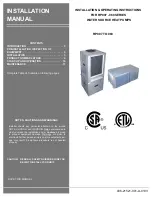
036-21521-001-A-0103
Unitary Products Group
9
LOOP WATER SUPPLY AND PIPING
CONNECTIONS
The recommended circulating water supply for
heat
pump
systems is a closed-water loop, utilizing a cool-
ing tower and boiler to maintain the loop temperature
within acceptable temperature limits. Typically, the
closed loop temperature is maintained above 60° F and
below 90° F. All units function independently, either
adding heat to the loop (cooling mode) or removing
heat from the loop (heating mode).
When utilizing an open cooling tower (evaporative
type), chemical treatment is mandatory to ensure that
the loop water is free of corrosive minerals. A second-
ary heat exchanger between the open cooling tower
and the closed water loop may also be used. It is
imperative that all air is purged from the closed loop
side to prevent condenser fouling.
Dual acting water regulating valves should be used
when there is potential for low fluid flow and/or low fluid
temperature or high fluid temperature conditions to
exist. These water regulating valve assemblies consist
of a direct acting valve parallel coupled to a reverse
acting valve. The direct acting valve opens in response
to an increase in discharge pressure during cooling
mode. The reverse acting valve opens in response to a
decrease in suction pressure during heating mode.
The heat rejection water source for
cooling-only
units
may be from a municipal supply main, a cooling tower,
or a chilled water system. An automatic water flow reg-
ulating valve is normally required, except if the inlet
water temperature is constant and the flow rate can be
pre-set and turned on and off by some other means,
such as a dedicated pump circuit or solenoid valve.
Automatic water flow regulating valves, for both heat
pump and cooling-only applications, are available as
field installed accessories. The valves are installed on
the water outlet connection from the unit. Schrader
type refrigerant pressure access fittings are included
as standard in all units.
SUPPLY/RETURN PIPING
Supply and return piping should be as large as the unit
connection sizes (larger on long pipe runs). Never use
flexible hoses of a smaller inside diameter than that of
the nominal water pipe size. Both supply and return
water lines will sweat if subjected to low water tempera-
tures. Insulate these lines as necessary to prevent con-
densation damage.
Flexible hoses should be used between the unit and
rigidly mounted piping to avoid vibration transmission.
Teflon tape thread sealant is recommended. Do not
overtighten threaded connections. Ball valves should
be installed in the supply and return lines for unit isola-
tion and water flow balancing. Before final connection
to the unit, the supply and return hoses should be con-
nected together and the piping system flushed to
remove any dirt or foreign material.
Pressure and temperature ports are recommended in
both the supply and return lines for system flow balanc-
ing. The water flow can be accurately set by measuring
the water-side pressure drop through the unit. See the
flow versus pressure drop specification table for appli-
cation information.
Do not exceed the recommended
water flow rates. Damage due to erosion of
the
water-to-refrigerant heat exchanger could occur.


































